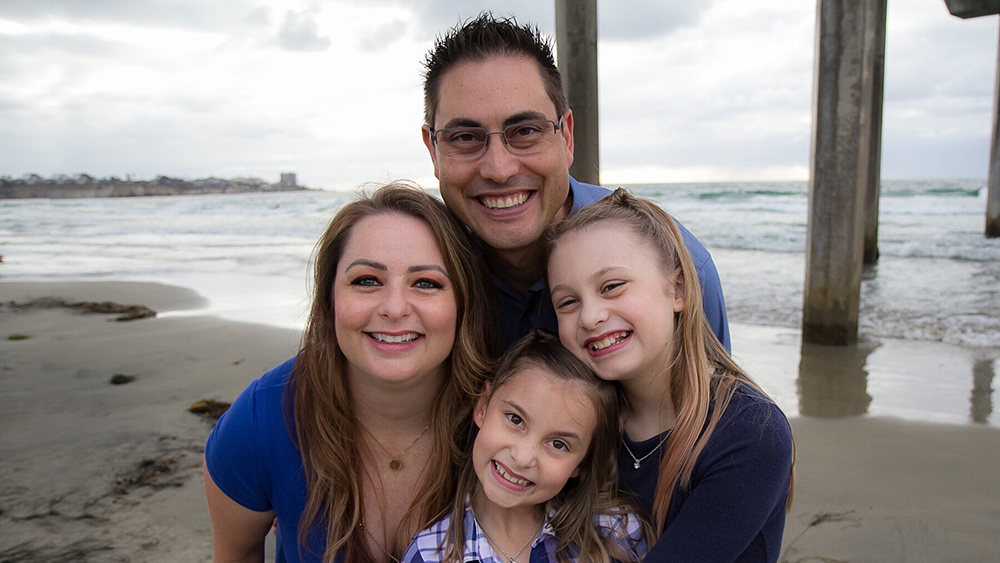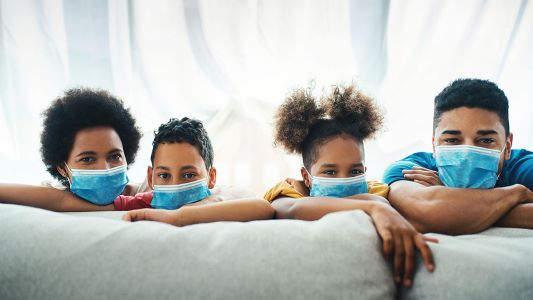Article Highlights
-
The Adolescent Brain Cognitive Development (ABCD) Study is a long-term study of brain development and child health.
-
Through surveys and tests, the study is capturing the impact of the COVID-19 pandemic on children.
-
Participants like 12-year-old Aurora Cross aren’t just informing present research — they’re shaping research for years to come.
Aurora Cross has more experience with MRIs than the average 12-year-old — and most adults. “It’s a cold room and I have to take my glasses off because they have metal in them,” she explained. She still needs to see, so she wears plastic goggles with prescription lenses popped in.
Aurora lies still inside the MRI machine while it takes images of the structure of her brain and her brain activity when she performs cognitive tasks. “You definitely want to fall asleep, but you can’t,” she said. “You play these games where you have to actually pay attention, not one of those games you can kind of zone out.” She does this for two hours, every other year, at the University of California, San Diego (UCSD).
Aurora is helping scientists learn how children’s brains grow and develop as they transition to adulthood. In 2018, when she was 9, she and nearly 12,000 other kids her age were invited to join the Adolescent Brain Cognitive Development (ABCD) Study, funded by the National Institutes of Health (NIH). Study staff will see her and the other young participants for regular tests, surveys, and MRIs until they are 18 or 19.
In the spring of 2020, COVID-19 pandemic shutdowns affected every child in the ABCD Study. Thanks to data collection that had already been going for two years, scientists involved in the study will have a unique perspective on the pandemic’s impact on long-term health.

Aurora Cross wears her ABCD Study t-shirt. Photo courtesy of Loralyn Cross.

Aurora Cross wears her ABCD Study t-shirt. Photo courtesy of Loralyn Cross.
An Ambitious Project
The ABCD Study is the largest long-term study of brain development and child health in the United States. Researchers are capturing both typical brain development and what happens in the brain when problems develop.
With MRI data, results from cognitive tests, and information from interviews and questionnaires with parents and children, the study is building an enormous database that will be useful to researchers with unanswered questions. The data will paint a portrait of biological and behavioral development through adolescence into young adulthood.
The research is supported by several NIH institutes and centers, all with unique interests in adolescence. For example, the National Institute on Drug Abuse (NIDA) seeks to understand the impact of substance use on adolescent brain, cognitive, social-emotional, and academic development. The Eunice Kennedy Shriver National Institute on Child Health and Human Development (NICHD) is interested in healthy brain development and traumatic brain injury. The National Institute of Mental Health (NIMH) aims to understand mental disorders, many of which emerge during adolescence. Several other institutes are also involved, with interests in other aspects of adolescent development.
“The pandemic has potential academic and social ramifications that I think we’ll be looking at for years.” —Susan Tapert, Ph.D.
Adjusting to Pandemic Life
In the spring of 2020, many school systems shut down in-person learning. Like a lot of kids, Aurora and her younger sister, Abby, had to adjust to online instruction. “It was rough. It was really rough,” said Aurora’s mom, Loralyn. “We weren’t functioning very well for a while.”
The scientists and staff who run the ABCD Study also had to adjust to conducting research in a virtual space.
“There were two things we needed to quickly do. One was to keep the study going even though we wouldn’t be able to see the kids in person,” said Susan Tapert, Ph.D., a professor of psychiatry at UCSD. Dr. Tapert is the associate director of the ABCD Coordinating Center, which keeps the study’s 21 sites working together.
“At home, the kids don’t have the whole array of equipment like we have in the lab, but almost every family has a smartphone,” Dr. Tapert said. The team moved almost every cognitive task to a web-based platform that works on a small screen.
The second task: to understand how the pandemic is affecting young lives. “This is a huge event for everybody in the world, and it definitely could have an impact on child and adolescent development,” Dr. Tapert said.
The study team developed surveys that they could send to participants and their parents, asking about their experiences during the pandemic. The first survey went out in May 2020, and six more were sent through July 2021. Questions covered topics such as whether children have had COVID-19 symptoms or come into contact with people who were sick; the economic impacts of the pandemic; changes in school, sleep, and activity routines; use of practices such as mask-wearing and handwashing; and vaccination status. As it became clear that masks reduce transmission of the virus, the study was able to transition back to having children come to the study sites in person for some of the testing.
Data from the ABCD Study participants, including the new survey data, are anonymized and periodically released for outside researchers to study.

ABCD Study
The ABCD Study is the largest long-term study of brain development and child health in the United States.

Clockwise from right: Aurora Cross; her sister, Abby; her mother, Loralyn; and her father, Ryan. Photo courtesy of Loralyn Cross.

Clockwise from right: Aurora Cross; her sister, Abby; her mother, Loralyn; and her father, Ryan. Photo courtesy of Loralyn Cross.
It Started One Movie Night
The Cross family found out about the ABCD Study during a movie night at Aurora’s elementary school. Staff from the study had set up a table with information. Loralyn was intrigued.
“I’m a person who likes to give back,” she said. Loralyn donates blood regularly, has signed up to be a bone marrow donor, and was even a surrogate mother once. When she was in college at UCSD, she saw a lot of flyers looking for research participants. “If there was an interesting study, I would sign up for it,” she said. In 2017, she enrolled in the All of Us Research Program, another long-term study funded by NIH.
Loralyn was excited about the chance to get one of her children involved in research, too. Aurora agreed that the ABCD Study sounded interesting and was willing to do the testing and sample collection, including giving samples of hair and saliva.
Observing Families
The ABCD Study’s researchers have built a cohort that reflects the racial, socioeconomic, and geographic diversity of the United States. This diverse group had a variety of experiences during the pandemic — for instance, some children had in-person schooling during the 2020–2021 school year, while others had online learning. This diversity will make it possible for researchers to explore how the pandemic has affected different groups in both the short and long term and what factors may have lessened the impact of the pandemic.
“The pandemic has potential academic and social ramifications that I think we’ll be looking at for years,” Dr. Tapert said.
Preliminary results show that families who were affected economically by the pandemic had higher levels of conflict. In families where a parent coped by drinking more, things could get particularly tense. “It looks like the parent’s response and coping can have an effect on family functioning and the well-being of the child,” Dr. Tapert said. Families who were able to maintain a routine — and the minority of kids who got more physical activity at home than before — seemed to be doing quite well. Consistent sleep times seemed to be helping with mental health. Children of parents who were not able to monitor them as much as usual, perhaps due to working more hours outside the home, were more likely to increase the use of substances such as tobacco and alcohol.
Loralyn and her husband were able to work full-time from home through the pandemic, so they didn’t take a financial hit. “We’re in a very privileged situation,” she said. But still, like many families, they struggled.
“During COVID, it was just about surviving,” she said. Routines, bedtimes, and exercise all went out the window, and she drank more than usual, too. Online school created new complications and new things to fight about. If an assignment wasn’t graded, was that because the teacher missed it, or did the child forget to upload it? Whose responsibility was it to keep track of the variety of platforms or to follow up? “There were tense moments and family fights, and frustrations — it was hard,” Loralyn said.
But this spring, the girls went back to school in person and everyone has been vaccinated except Abby, who is too young. Stress is down, exercise is back on the schedule, and both parents are drinking less.
The family has emerged stronger, Loralyn said. “You really can’t appreciate the wonder, or the beauty, or just how lucky you are unless you’ve been through times where you didn’t have that and you know how hard it can be. We’re all just really grateful for our health, grateful for our family, and grateful for all the things we have.”
 An official website of the United States government
An official website of the United States government


